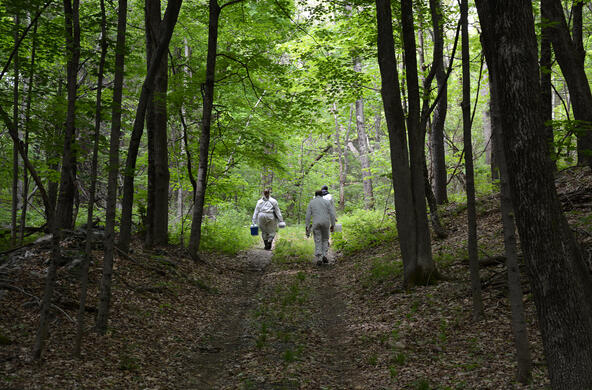Everybody knows about Lyme disease. But experts say the Northern United States may be in for a bad tick season this summer, raising concerns about Lyme and other scary tick-borne diseases, including the Powassan virus, which causes encephalitis and can leave people with permanent neurological damage.
“This spring definitely seems worse than others I remember,” said Dr. Catherine Wiley, chief of general pediatrics at Connecticut Children’s Medical Center. “People are coming in from the yard with numerous ticks on them.”
When we think of ticks, we tend to think of deer, but Richard S. Ostfeld, a senior scientist at the Cary Institute of Ecosystem Studies in Millbrook, N.Y., said it’s really all about mice. He has been studying white-footed mouse population ecology for the past 25 years. Every four or five years, he said, there’s a bumper acorn crop, so more mice survive the following winter, breed and reach what he called “mouse plague levels” in the summer.
These mice will be the main source of infection for the tiny larval ticks that hatch in August and can attach to many mammals and birds, which will try to groom them off. Mice “are just not fastidious groomers,” Dr. Ostfeld said, so their ticks tend to survive. Those larval ticks then morph into the nymph stage and stay dormant through the following winter. And then, in late spring through early summer, the nymphs begin to feed. It’s those nymphs, infected in the larval stage by mice, that transmit the infections to humans.
So what we’re worried about this summer goes back to 2015, which was one of those big acorn years; “2016 was the biggest mouse year we’ve seen in our entire 25 years of monitoring them,” Dr. Ostfeld said.
“We’re likely to see more ticks, and a lot of us have already started seeing more tick-borne infections,” said Dr. Nicholas Bennett, the head of the division of pediatric infectious diseases and immunology at Connecticut Children’s Medical Center.
“Far and away, the most common infection I see is Lyme,” Dr. Bennett said. The bacteria is present in many ticks — more than half of them in some areas — but only about 3 percent of tick bites result in infection. Once the tick attaches and starts feeding, the bacteria have to undergo maturation within the tick before transmission is possible, so it takes at least 36 hours from the time an infected tick bites until Lyme disease can be transmitted, which is why people are told not to worry about Lyme if they find and remove a tick soon after a child has been outside. (On the other hand, if you do find that tick, it reminds you that you’re in an endemic area and may have had other bites.)
The classic symptom of Lyme disease is the bull’s-eye rash called erythema migrans. But the diagnosis is not always obvious. “Half the people who have clear Lyme don’t remember getting bitten and never have a rash,” Dr. Bennett said.
If a child doesn’t get better with the usual antibiotic treatment, doctors may suspect a second infection, like babesiosis or anaplasmosis, since some ticks carry more than one disease, and since the first-line antibiotics we use in children for Lyme don’t treat the other tick-borne infections. Anaplasmosis and babesiosis are less common, Dr. Bennett said, though regional infection rates may vary. And Powassan, though it is the rarest, is scary because it can be transmitted so quickly, and because, since it is a viral infection, there is no antibiotic treatment. Detailed information on all the tick-borne diseases is available on the website of the Centers for Disease Control and Prevention.
Later complications of Lyme disease can include painful Lyme meningitis, or a nerve palsy, which can make it look as if one side of a child’s face has just stopped working. “In Connecticut, if your kid has a facial nerve palsy, it’s Lyme disease,” until proven otherwise, Dr. Bennett said. And eventually, children may develop Lyme arthritis.
Whether it’s a bad tick year or a good tick year, Dr. Bennett said, “the preventive message is pretty much the same.” It’s all about tick checks and using repellents, spraying DEET on your arms and legs, wearing clothing that covers you. The American Academy of Pediatrics recommends products with no more than 30 percent DEET for children, and no repellents at all for babies under 2 months old, who should just be kept away from the vegetation where ticks may be lurking.
“Tick checks are top of the list: Look kids over or bathe them when they come in,” Dr. Wiley said. She tells parents, “look in the hair, under arms, groin, waistline, around the ears, inside the belly button.” If the child has just come inside, the ticks are often not attached, and parents can just take them off, flush them down the toilet and wash their hands.
If a tick is embedded, “do not paint it with nail polish, burn it or try to smother it,” Dr. Wiley said. Instead, pull it off with fine-point tweezers, grasping the tick gently close to the skin, and pulling it out while trying not to detach the body from the head. The New York Department of Health website has a helpful tick-removal video.
“If you’ve been out in an endemic area, take a shower and change your clothes,” Dr. Bennett said. It’s also important to try to protect your pets, he said. Dr. Wiley suggested prevention strategies in the back yard, keeping long grass away, creating a barrier where the yard ends and the woods begin, and keeping deer out of the yard.







